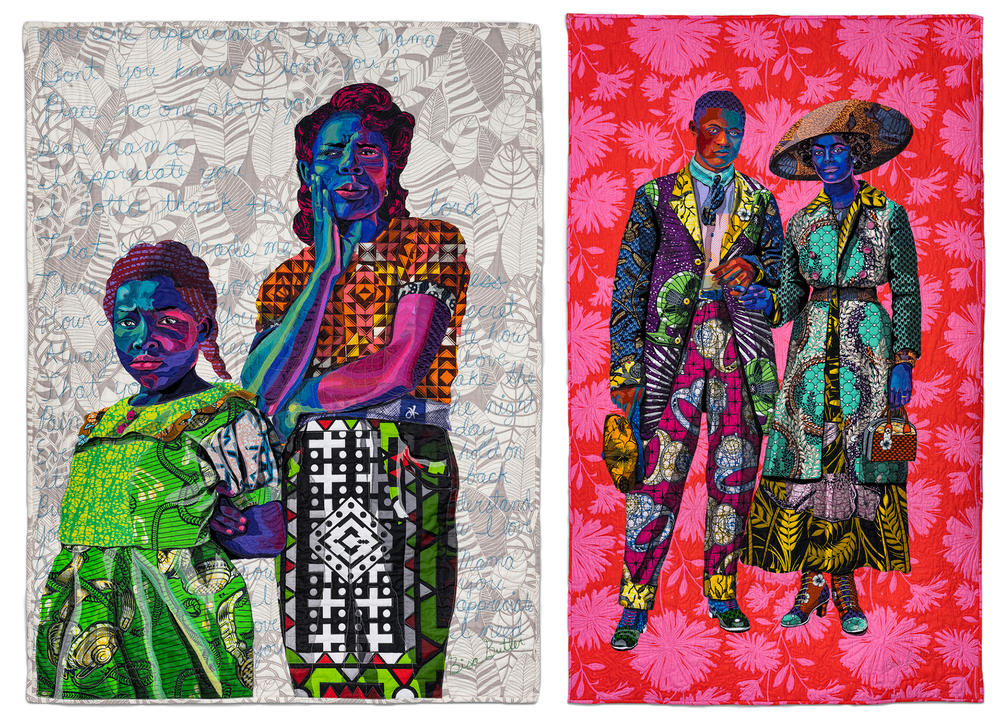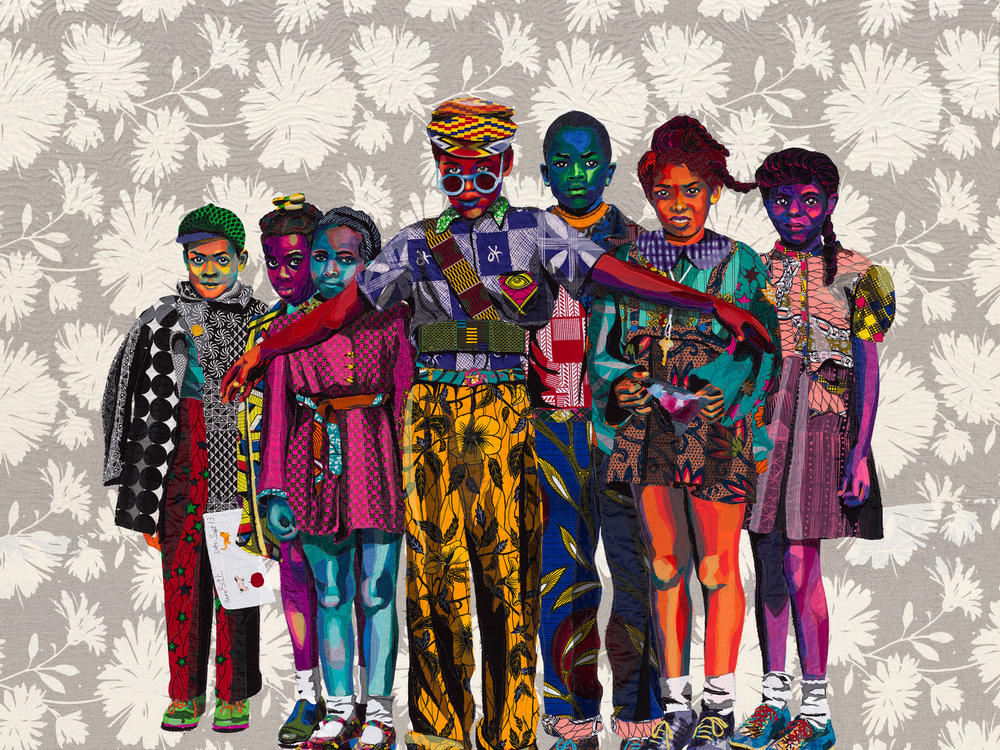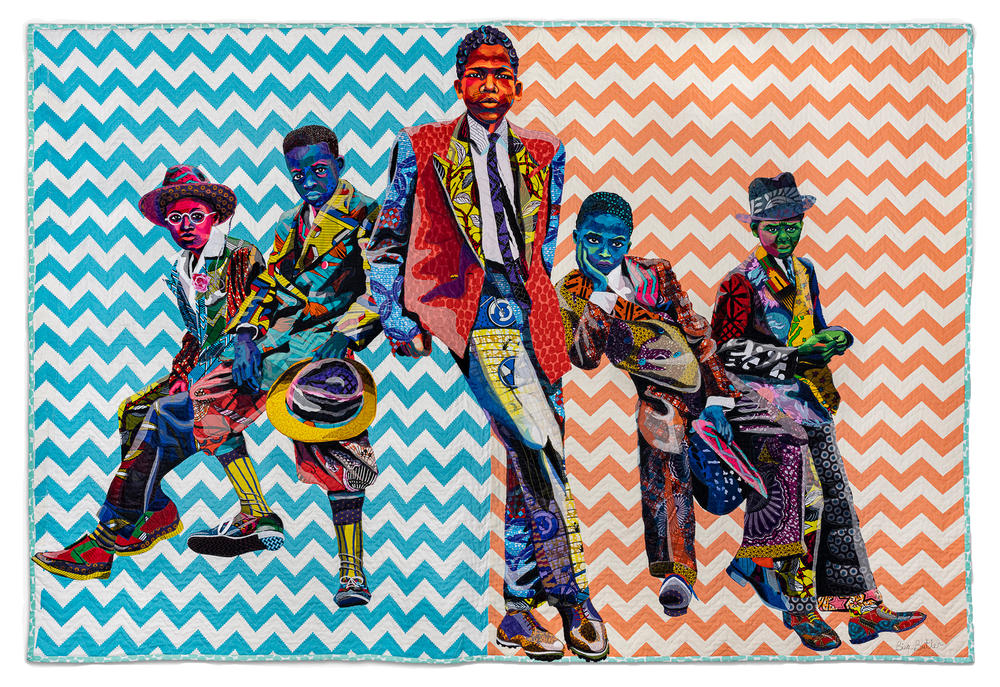Section Branding
Header Content
Black Lives Are Celebrated In Bisa Butler's Extraordinary, Technicolor Quilts
Primary Content
At the top of the Grand Staircase at the Art Institute of Chicago hang massive, colorful banners announcing the art work of Bisa Butler.
Butler's specialty is fabric, specifically quilts. And the bold images of Black people she stitches together, using textiles like paint in an explosion of color, is quilting transformed.
"I describe my artwork as a quilted photo album of a Black family. But it's the Black diaspora family," says Butler, standing in the exhibition hall and overlooking her work.
She explains that some of the people depicted in her photo album are well known, others just ordinary folk often overlooked. No matter. All are celebrated.
"These ordinary folk who may have been very poor are some people who should be highly regarded, the love in the care that they have for each other, the way they're presenting themselves," she says. "I see the dignity and the beauty. So I want other people to see that."
This is her first solo museum exhibit, which debuted in New York. Many of the works are based on archival photos from the 1930s and 40s.
Among them is Butler's "Safety Patrol." The exhibit's opening quilt is her version of the 1947 photo of seven school children taken by preeminent African-American photographer Charles "Teenie" Harris.
"Somehow I feel like they're calling out to me," Butler says. She worked on this quilt during her last year of teaching art to high schoolers in 2018.
The life-size figures pulsate with their own individual vibrant hues. The young boy in charge, holding his school mates back from crossing the street, wears a Nigerian batik print shirt.
"He's looking down his eyes at us," Butler says. "He even has on a little cap, like he's an officer, but he is. He's a safety patrol officer. So this was the quilt that I made, in a way, to reinforce to myself that the kids would be fine."
Like a painter, Butler selects her palette using fabrics from Ghana, her father's homeland, as well as other African countries. Her mother, from New Orleans, was raised in Morocco.
"I'm thinking about color as a way to express inner emotions or personality traits and I'm selecting African fabric to talk about the fact that we are of African descent and we have a long history that was taken," Butler says. "It is known that we have lineage and we come from people. So I want that to be acknowledged and I'll choose different fabrics depending on what the story is."
It is an in-depth artistic effort, which means Butler will spend about 200 hours creating a quilt.
The Art Institute's Associate Curator of Textiles, Erica Warren says the museum has been collecting quilts since the early 20th century and has a collection of about 230 of them. Warren says Butler's quilts resonate across the disciplines of painting, photography and textiles.
"It's not like any other quilt I've ever seen. And it's not like any other portrait I've ever seen," she says. "There's an opportunity there to kind of look at the work from so many different points of view."
She uses fabric like paint to create something extraordinary
The intricacy of the quilts — the billowy dresses for four little girls, the layered fabrics that make up a background — astonish many of the gallery visitors who pull out their cameras for pictures. Kamau Grantham, a clinical psychologist, toured the exhibit with his 9- and 12-year-old sons.
"It's amazing." Grantham says. "The breadth of the work, the details, the colors."
Meya Garrett, 16, is a Collins Academy High School senior and was taken with the quilt of a 7-year-old girl, her hair tied in pigtails.
"I like how it portrays Black people," Garrett says, "and she usually uses flowers or like a shiny fabric for the hair and stuff like that to portray Black women's curly hair."
Melanie Meade and Terri Raulie, a stagecraft and design professor, were transfixed by Butler's quilt "Survivor" which tackles the issue of female genital mutilation. In Butler's rendition of a photograph of a young Kenyan tribeswoman who had undergone a circumcision, fabrics of deep purple and red make up her face and her eyes look directly at viewers.
"They just pierce you," says Meade, with Raulie immediately adding, "Survivor over there, it just breaks your heart. You can feel it. You can feel that story telling, you know in a quilt. In Fabric."
Music and art blend to create their own playlist
Butler, who writes narratives about her artwork on social media, says she wants people to understand what she's trying to say about her work and about Black people.
She also wants people to listen. With each quilt there's music, a song of their own. Butler collaborated with her husband John, a professional deejay, to create the playlist, a mix of classic and current artists with something to say.
John Butler's studio, in the basement of the couple's home, is underneath the room where his wife works.
"So his music is always a part of my work," Bisa says. John adds, "All through out our relationship it's been music and art and they are one and the same. They are cut from the same cloth, they're from the same thread."
The Butlers say that made it easy for them to come up with songs from artists like Tupac Shakur, Muddy Waters, Mahalia Jackson, Jill Scott and others to meet the artistry of the Bisa Butler quilts.
In one gallery, Butler, dressed in an African-print pantsuit as colorful as her portraits, stands in front of a quilt which she calls "Southside Sunday Morning." It's her version of the iconic photo by Russell Lee, called "Negro Boys on Easter Morning."
The boys dressed in their Sunday best — suits and ties and hats — sit on a car on the South Side of Chicago. There's no car in the Butler quilt.
"One boy, in the original, his foot is resting on a license plate but I love to show that he's so "clean", that even the soles of his shoes are clean," she laughs. "And this piece it talks to me about how our community loves our children."
Butler trained as a painter at Howard University before getting her graduate degree at Montclair State University in New Jersey. The Art Institute exhibit also includes the work of artists who influenced her, such as Romare Bearden, photographer Gordon Parks, Barbara Jones Hogu and other members of the AfriCobra collective formed in Chicago in the 1960s to affirm a Black aesthetic in visual arts.
Butler's artistry, though, is part of a family tradition — a knowledge of textiles and clothing passed down from her mother and grandmother both accomplished seamstresses. Typically considered a craft, Butler agrees the art world is beginning to give quilting its due.
Her "Portraits" will remain on display in the fine art galleries of the Art Institute of Chicago until Sept. 6.
Copyright 2021 NPR. To see more, visit https://www.npr.org.



